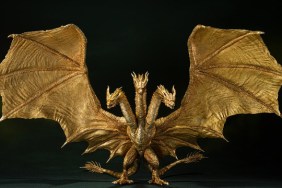
Leading us to the first soundstage, Heimdall’s Observatory, Feige made clear that this version of Thor is based on the classic version of the character as he appeared in Marvel’s 616 continuity. Though he’s a big fan of the “Ultimates” comics, it’s not the version of the character he wanted to bring to the big screen. This Thor is first and foremost based in science fiction fantasy, splitting the film’s runtime between Asgard and Earth, 60/40.
Entering the Observatory, it sank in how massive the production is when it comes to physical sets. Built by production designer Bo Welch, the observatory is (according to Feige) one of the smaller designs for the film. A a full-scale bit of Norse architecture, the magnificent structure is covered in runes and ornamental carvings. Beginning at one end, a bridge is surrounded by greenscreen, leading to the center of the observatory, a chamber build around a tremendous sphere that seems to be overgrown with some sort of tree. At the furthest end of the bridge, there was a figure trapped within a frozen block of ice, but it was impossible to make out exactly who it might be. Feige laughed and told us that we’ll just have to wait to figure that one out.
“This [room] was extended out to Asgard and out there [is] deep space,” Feige explained, “This, in the center, is where Heimdall stands to control it. The whole grid on the outside begins to spin and there’s a turret up that launches them in this direction as all our characters are sent out on their merry way across the universe.”
After the announced delay in Thor’s release date some time ago, a lot of work was poured into developing the sets for the film, something that Feige said really sets this specific world apart from a lot of other Marvel properties.
“This isn’t just one Batcave or one X-mansion. It’s a half-dozen to a dozen Asgardian realms and sets.”
“Once you step inside [the observatory], you basically tell Heimdall where you want to go,” added Kyle, “The sword Heimdall uses is not only used to defend Asgard, but it’s also the key to this device.”
The props for Thor are tremendously important, too, and the film is said to include a scene that depicts Odin’s vault where Feige teases that we won’t just be privy to the objects that set Thor’s plot in motion, but the macguffins for future Marvel films as well.
“Asgardians have kind of ‘been there, done that’ when it comes to [technology],” said Kyle, “So for them to send you across the universe, it’s as easy as turning a key. That’s why it’s a system of gears and wheels. It’s a machine. Their technology is only as sophisticated as it needs to be to do extraordinary things.”
That’s part of the central conceit for the film. While the character is, indeed, a part of Earth’s mythology and was believed to be a Norse God, it’s ultimately because of the incredible Asgardian technology that enabled Thor to visit Earth in the distant past and leave such a magnificent impression. Going by Arthur C. Clarke’s famous science fiction rule that, “Any sufficiently advanced technology is indistinguishable from magic,” the Asgardian technology becomes the stuff of science rather than fantasy. It’s merely so advanced that we can’t necessarily tell the difference.
“Once you’ve said where you’re going to go,” Kyle continued, “you’re fired across the universe. You get the Rainbow Bridge when you arrive or leave Asgard, but when you want to get from this side of the universe to ours, you need to step through this gun.”
Taking a place above our group atop the device at the center of the structure, Feige answered some questions before turning us over to Kyle for the rest of the day. In the midst of several productions at once, Feige has to run out and deal with Captain America: The First Avenger, setting up pre-production in a nearby office.
“[Thor] is a hard one,” Feige admitted about bringing the character to the screen, “When you walk around Captain America or Iron Man, you can get it. With Thor, what you’re seeing is only 30% of what the movie will be. This is the big question mark and, to me, that makes it the most exciting. I like it when people don’t exactly know what we’re going to do. I liked it when people said, ‘Iron Man’s the B-Team. You’re calling out the B-Team!’ We knew it wasn’t. We knew it was going to be great. And that holds true for “Thor.” Being able to stand in sets like this having done almost 18 Marvel movies at this point to know here’s another one that will redefine us and at least raise the bar of what a comic book movie is, for both people who’ve read comics and those who haven’t.”
Speaking to Thor’s 3D conversion, Feige pleaded ignorance when it came to various methods of achieving the effect.
“There are conversions that don’t work at all and I think there are conversions that I would never have known were conversions,” he explained, “There have been sequences and shots in movies that were filmed in 3D that have been converted where the cameras didn’t work and they had the shot in 2D and had other companies convert it and I can’t tell the difference… [Pete Docter] talked about how he didn’t design shots for 3D [for Up], he designed shots to tell the story and then he used 3D to tweak certain sequences and certain shots.”
Bidding us adieu, Feige told us all to have a great time and issued his apologies that Thor himself, Chris Hemsworth, wouldn’t be around for today’s shooting.
“Do not judge the Thor double as Thor,” he laughed, “When Chris is Thor — well, let me just say there are certain individuals who begin questioning their sexuality.”



